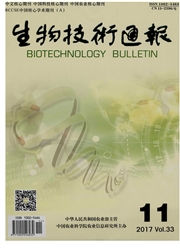

 中文摘要:
中文摘要:
为了探究拟南芥IQM5基因是否存在不同的剪切方式及其器官特异性表达,利用RT-PCR技术和T-A克隆发现了IQM5基因的一种新的剪切方式,即IQM5.2。利用生物信息学方法、半定量和定量RT-PCR分析方法分别对新的CDS序列所编码蛋白的性质以及IQM5.1和IQM5.2在不同器官中的比例进行了分析。结果表明,IQM5.2编码1个由300个氨基酸组成的多肽,其N端与豌豆重金属诱导蛋白6A(HMIP6A)具有较高同源性,含有1个IQ基序,属于钙不依赖性钙调素结合蛋白;在幼苗、莲座叶、花序叶、茎和花蕾中都存在IQM5.1和IQM5.2的转录本,且二者的比例在不同的材料中不尽相同。因此,IQM5基因存在不同的剪切方式和器官特异性表达。
 英文摘要:
英文摘要:
The Arabidopsis IQM5,the fifth member of IQM family,is encoded by At5g57010. So far,there is only one splicing mode found for the IQM5 gene in the biological literatures and databases,i.e.,At5g57010.1(IQM5.1). In this study,a new splicing mode for IQM5 gene was found by RT-PCR and T-A cloning method,designated as At5g57010.2(IQM5.2). Bioinformatics methods and semiquantitative and quantitative RT-PCR were employed to analyze the properties of proteins encoded by new CDS sequence,and the ratio of IQM5.1 and IQM5.2 in different organs,respectively. The results revealed that IQM5.2 encoded a polypeptide of 300 amino-acid residues,and its N-terminus shared sequence homology with the pea heavy metal-induced protein 6A(HMIP6A). The protein retained an IQ motif and was a calmodulin-binding protein of the calcium independent. There were transcripts of IQM5.1 and IQM5.2 in the seedling,rosette leaf,cauline leaf,stem,and flower bud,moreover,the ratios of them in the different organs varied.
 同期刊论文项目
同期刊论文项目
 同项目期刊论文
同项目期刊论文
 Chloroplast phylogenomic analyses resolve deep-level relationships of an intractable bamboo tribe Ar
Chloroplast phylogenomic analyses resolve deep-level relationships of an intractable bamboo tribe Ar 期刊信息
期刊信息
